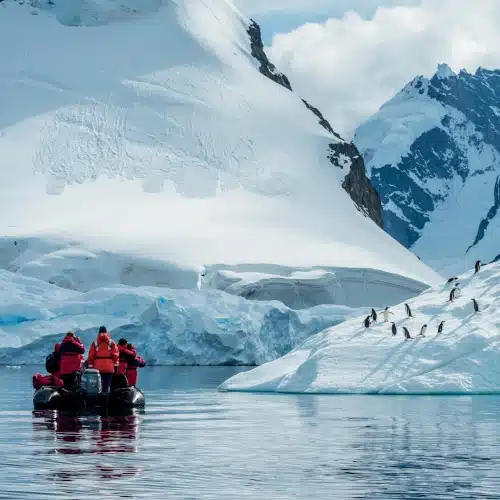A journey to the origins of the earth
Exploring Antarctica has always represented one of the most extreme challenges. This continent – synonymous with adventure and science, and essentially known to just a handful of international researchers – continues to inspire some of the planet’s most imaginative minds with its ever-more extraordinary natural mysteries. A bellwether for our planet’s climate, the vast white continent still has plenty of surprises in store!
Antarctica’s hidden lakes: a watery world beneath the ice
Just as a whole world lies beneath our city streets, there is water under the Antarctic ice! To date, we have discovered about 400 subglacial lakes deep below the frozen continent. The most famous example is Lake Vostok, which lies under four kilometres of ice, is three times larger than Lake Ontario and extends to depths of 3,400 metres. Lake Whillans, on the other hand, is bursting with an incredible wealth of microbial life! But many more are still waiting to be discovered. In fact, there is a whole network of hidden lakes (some of them interconnected by rivers) that fill and empty thanks to phenomena that remain largely a mystery to us, but which have a definite effect on movement in the ice sheet and potentially influence ocean currents around the world as a result. It’s mind-blowing, wouldn’t you agree?
The icy fires of an Antarctic volcano
In addition to lakes, Antarctica’s frozen expanses are also home to many hidden volcanoes. In fact, it might even be the largest volcanic region in the world! 168 volcanoes that are either dormant, extinct or active are currently known to us, but it is thought that many more exist – perhaps even enough to rival the East African Rift! The subglacial eruptions of the active volcano on Deception Island, in the South Shetlands to the north of the Antarctic Peninsula, make it a particularly rare example of its kind. There is also the magnificent Mount Erebus, which ascends to heights of 3,794 metres on Ross Island and is the most active volcano on the continent. A lake of molten lava bubbles at the base of its crater.
The Transantarctic Mountains: a vertiginous spine running through the pole
Antarctica is divided into eastern and western regions. Between the two runs a magnificent river of rock known as the Transantarctic Mountains. This system of mountain ridges interspersed with glaciers extends out over 3,200 km from Victoria Land to the Weddell Sea and is one of the longest and oldest in the world. While the chain reaches its highest point at Mount Kirkpatrick at an altitude of 4,528 metres, it includes around 20 peaks that also exceed altitudes of 4,000 metres. This unique natural rock formation is extraordinarily rich in fossils, making it a palaeontologist’s paradise. For example, it was here that fossilised prehistoric reptiles, amphibians and trees were uncovered in the Triassic-aged Fremouw Formation.
The McMurdo Dry Valleys: the most mysterious of deserts
The McMurdo Dry Valleys in the Transantarctic Mountains are among the harshest environments on the planet. With its 15,000 km2 of unfrozen terrain, it is one of the most extreme deserts in the world and might even be drier than the Atacama Desert. This rocky, windswept landscape is millions of years old. Only a few plants nourished by summer meltwater survive there, accompanied by a few rare microorganisms. It is in the dry valleys of McMurdo, on the edges of the Taylor Glacier, that we can observe a naturally occurring phenomenon known as Blood Falls, created when iron-rich salt water surges out of cracks in the glacier to create an astonishing red colour.
The world’s fastest katabatic winds
Antarctica’s katabatic winds are among the most powerful in the world, and they gather their speed by running through the continent’s plateaux and mountains. They are the reason the McMurdo Valleys are so dry. These masses of cold air race down the crevassed faces of the mountains from their icy peaks, getting warmer and drier the further they descend and dissipating all water (liquid or solid) in their paths. The current record for the fastest wind was broken near the Dumont d’Urville Station at Adélie Land (where altitudes can quickly rise to heights of 3,000 metres), with gusts blowing at nearly 320 kilometres per hour!
Rocks from the heavens
45,000: this was the number of meteorites found in Antarctica in 2022. In fact, in January 2023, a team of researchers found a rare specimen weighing 7.6 kg (most meteorites usually only weigh a handful of grams once they have passed through our atmosphere)! This makes Antarctica one of the world’s favourite places for hunting space rocks. One of its great advantages is its vast and immaculate expanses of white space, which make it easier to spot the black rocks. Another is its dry climate, which guarantees their conservation. Add to this the way the ice drifts, concentrating the meteorites in a single area, and the movement of the glaciers, which helps to keep them at surface level. Its wealth of meteorites makes Antarctica an invaluable resource for gaining a better understanding of our solar system and our place in the universe.
Photo credits: ©iStock; ©StudioPONANT

PONANT takes you there
Explore the world’s most mysterious shores.


